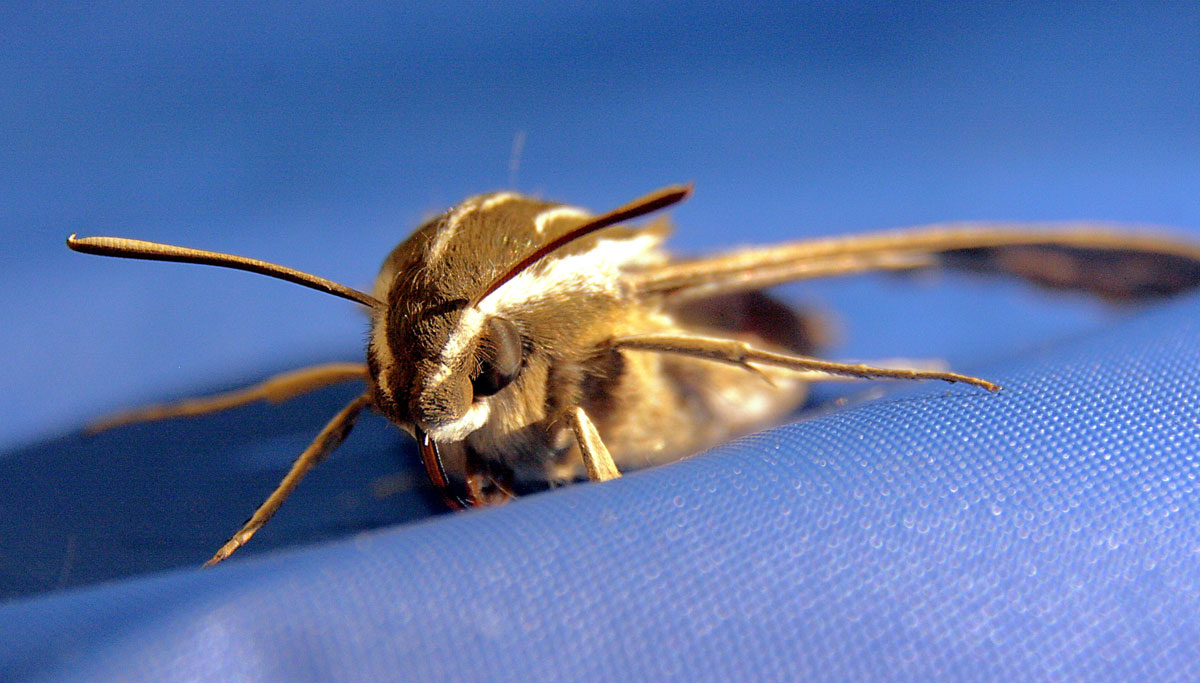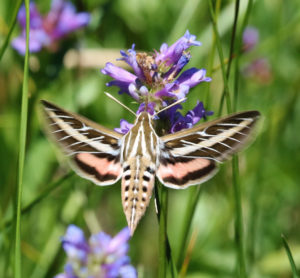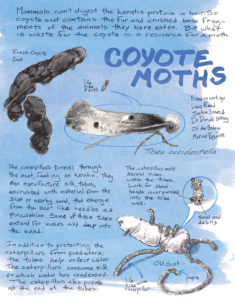uiet descends on the El Cerrito Hillside Natural Area after sunset. The 102-acre plot of protected land overlooking the city of El Cerrito is heavily trafficked by hikers, runners, and dog walkers during the day. Under the cover of darkness, though, humans are a rare sight, and nocturnal creatures are free to rule the hill.
But tonight, the El Cerrito Hillside is uncommonly full of human bodies. Just above the Schmidt Lane entrance is an anomalous crowd: more than 40 people, gathered around the exposed bulb of a white light illuminating the hanging white sheet behind it. The people are all staring, transfixed.
On the sheet crawls a large, furry white-lined sphinx moth. Its body is thumb-length, slim and streaked with white. For a moment, it lifts from the sheet, its two-toned wings a swift-beating blur. The crowd gasps. It lands again, and walks in slow circles around the light, furry antennae probing its path. “I can’t see!” shouts a child, and her father hoists her onto his shoulders.
The crowd and the moth have gathered for Moth Night, a citizen science event organized by Friends of Five Creeks to observe the diverse populations of this often-overlooked insect.
“Moths are definitely under-appreciated,” said Eddie Dunbar, the executive director of the California Insect Sciences Museum and the evening’s attending moth specialist. “People are scared of them. You don’t really get to see them, except when they’re knocking on your window or crowding your porch lights.”
Dunbar recalled his own early impression of moths: the 1961 film Mothra that depicts a monster moth attacking Japan. “I remember, even as a kid, I knew there must be more to the story of moths,” he said.
In fact, moths are crucial to this hillside ecosystem. “When people think of pollinators, they think of butterflies and bees,” Dunbar said. “But moths outnumber butterflies ten-to-one.”
Because of its diverse plant populations, the Hillside is an attractive spot for these nocturnal insects. Dunbar estimated that it is home to about 30 different species of moths. But events like this Moth Night help him collect more exact data, and increase citizen awareness in the process.
For Susan Schwartz, president of Friends of Five Creeks, the event was not just about the moths. “We’ll take any opportunity we can get to learn about the hillside and all of the species that live here,” she said. “One hundred acres of protected land in a city is highly unusual. We need to work to understand it.”
Before sunset, Schwartz invited the citizen scientists for a short hike to learn more about the moths’ home. As she led the group up the steep service road that slices the grassy, tree-spotted hillside, she pointed out various native and non-native plants. Hiking boots crunched over a carpet of fisted oak leaves. The licorice-odor of fennel carried on the air, mingling with the dusty scent of eucalyptus.
The hikers crested the hill to an astounding view. From the Richmond Bridge to the Golden Gate, a great expanse of flushed sky touched the dark surface of the San Francisco Bay with rosy light. A glinting BART train, elevated on its track above boxy rooftops, streamed through the city with its high-pitched whine. Across the bay, the sun was just beginning to slip behind Mount Tam, rimming the darkened ridgeline with an orange glow. “This cliff is what we call alien terrain,” Schwartz said. “We’re standing on rock from who-knows-where, that got stuck onto North America when the Farallon plate was subducted millions of years ago.”
On the way back down the hill, hikers spotted a great horned owl and a red-tailed hawk, perched on adjacent branches of two eucalyptus trees.
“This is the beauty of the East Bay,” said a hiker from the group El Cerrito Trail Trekkers, which helps maintain the open space. He followed the hawk with his binoculars as it lit from its branch and slipped through the dusky cover of oaks. “Down there is the city, and up here you can see something like this.”
Dunbar’s white lamp guided the way back to the base of the newly darkened hill. The hikers settled around the lamp, awaiting the arrival of the mysterious nocturnal dwellers of their familiar hillside. Illuminated against the white sheet, even mosquitos became an object of wonder to photograph and record. It wasn’t long before the moths came out.
“A moth just hit me in the face!” said a young boy.
“That’s because you’re a shining light,” replied a Trail Trekker.
Many of the moths were tiny and almost invisible against the sheet, fluttering around the light like flecks of torn paper. The white-lined sphinx was a crowd pleaser, a reminder of the alien majesty of these night-roaming creatures.
After analyzing his photographs and results, Dunbar said the event found only four moth species: the sphinx moth, the emerald moth, the pug moth –and one moth he’d never seen before. But for Schwartz, the real achievement was a raised awareness of a remarkable organism in a remarkable zone of protected land.
“I think this land is like the moths that live here: maybe it’s unusual, maybe it’s under-recognized,” Schwartz said. “But it sure is special.”





-232x300.jpg)